MaryAnn Bernal's Blog, page 205
January 9, 2015
History Trivia - Byzantine Emperor Zeno flees his capital at Constantinople
January 9
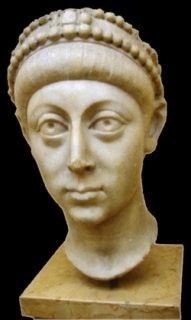
475 Byzantine Emperor Zeno was forced to flee his capital at Constantinople.
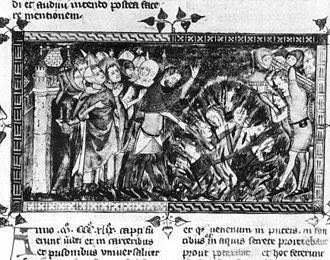
1349 The Jewish population of Basel, Switzerland, believed by the residents to be the cause of the ongoing Black Death, were rounded up and incinerated.
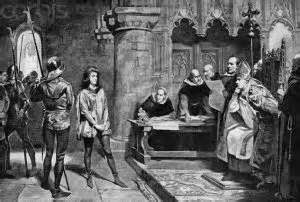
1431 Judges' investigations for the trial of Joan of Arc began in Rouen, France, the seat of the English occupation government.


475 Byzantine Emperor Zeno was forced to flee his capital at Constantinople.

1349 The Jewish population of Basel, Switzerland, believed by the residents to be the cause of the ongoing Black Death, were rounded up and incinerated.

1431 Judges' investigations for the trial of Joan of Arc began in Rouen, France, the seat of the English occupation government.

Published on January 09, 2015 03:00
January 8, 2015
Pharaonic Rock Carvings Found in Egypt
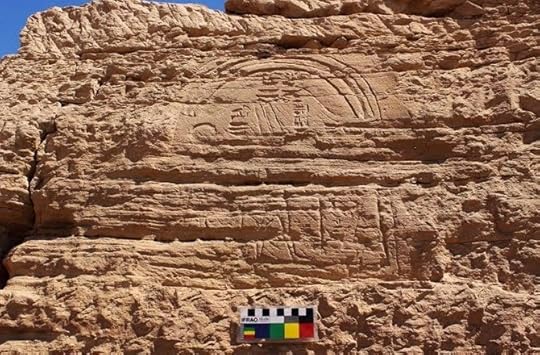 by Rossella Lorenzi Discovery News A rare wall relief showing an unidentified pharaoh has been discovered within the sandstone quarries of Gebel el Sisila, north of Aswan.
by Rossella Lorenzi Discovery News A rare wall relief showing an unidentified pharaoh has been discovered within the sandstone quarries of Gebel el Sisila, north of Aswan.Carved into the vertical face of the quarry wall, some 5 feet above the ground, the stela depicts the pharaoh presenting offerings to Thoth, the ancient god of wisdom, and Amun-Ra, the king among gods.
PHOTOS: Egyptian Pharaoh Carved in Quarry
“It’s particularly rare for these two deities to be portrayed together,” Lund University archaeologist Maria Nilsson, director of the Gebel el Silsila Survey Project, told Discovery News.
She added the three figures are rather poorly preserved, although some details can be made out.
“We can see the characteristic double feather crown of Amun-Ra, and the moon disc of the ibis-headed Thoth,” Nilsson said. “Unfortunately, the item presented by the pharaoh is no longer discernible.”
Mystery Pharaoh Found in Egypt
Preliminary study suggests the stela dates to the late dynastic period, perhaps the Third Intermediate Period, which began with the death of pharaoh Ramesses XI in 1070 B.C. and ended with the foundation of the Twenty-Sixth Dynasty by Psamtik I in 664 BC.
Readable inscriptions on the stela are merely titles of the gods, “Amun-Ra, King of the Gods, Lord of (-)”, and “Thoth, Twice Great, Lord of (-)”.
Just below the winged solar disc of the pharaoh, adorned with two uraei (stylized Egyptian cobras symbols of royalty and deity) the text reads: “Lord of the Two Lands, Behedet (Horus of Edfu).”
The personal text of the pharaoh is limited to “Lord of the Two Lands” followed by a poorly preserved cartouche and a short epithet.
“The team is currently trying to retrieve more information, but the area of the figure and title of the pharaoh is eroded by wind and sand, not to mention a natural fracture in the rock,” Nilsson said.
Roman Emperor Dressed as Pharaoh in Newfound Carving
The finding is the result of an epigraphic and archaeological survey mission of Lund University, Sweden, that has studied the site since early 2014.
The researchers have discovered more than 60 rock art sites on both sides of the Nile that date from the Epipalaeolithic (about 8500 to 6500 B.C.), Predynastic (about 4000-3100 B.C.), and Early Dynastic (about 3100-2686 B.C.) periods.
“Overall, the Gebel el Silsila repertoire consists of mainly abstract patterns, curves and lines, circles and dots, ladder-shaped drawings and a few stylized animals and reptiles,” Nilsson said.
However, there are several unique patterns that are far more elaborated than the abstract designs.
Among the most spectacular discoveries is a rare depiction of two obelisks being cut and loaded onto boats.
Ancient Amulet Discovered with Palindrome Inscription
According to Nilsson, the scene, which is currently studied and analyzed, is particularly important as it may change the chronology of the site’s most famous monument, known as the Speos of Horemheb. This rock-cut temple which is believed to have been originally carved for King Horemheb (1323–1295 B.C.).
“Now, based on a similar contemporaneous scene, we think that it belongs to the early 18th dynasty, possibly to Queen Hatshepsut (1473–1458 B.C.),” Nilsson said.
Nilsson’s team plans to create a detailed archaeological map of the area as well as a 3-D reconstructions of selected monuments.
“We also hope to start smaller excavations that will bring new information about the extraction and transportation techniques, as well as giving us a better understanding about the daily life in the quarry,” Nilsson said.
Image: The rock carved stela with the pharaoh to the right. Credit: Gebel el Silsila Survey Project.
Published on January 08, 2015 06:31
Easter Islanders Petered Out After Europeans Came
 The Rapa Nui are famous for the massive maoi statues that they erected on Easter Island.
The Rapa Nui are famous for the massive maoi statues that they erected on Easter Island. Thinkstock
Discovery News
A new way of looking at the history of the Rapa Nui, the civilization that lived on Easter Island, reveals details about how they lived before Europeans arrived on the island in 1722.
It's long been theorized that the Rapa Nui disappeared because they overfarmed their land, leading to widespread starvation and, it's said, maybe even cannibalism.
But a group of scientists from the United States, Chile and New Zealand, writing in the most recent Proceedings of the National Academy of Sciences, found that ancient obsidian artifacts from the island told a different story.
Easter Island Statues Could Have 'Walked'
"This analysis demonstrates that the concept of “collapse” is a misleading characterization of prehistoric human population dynamics," the authors wrote in their summary statement.
The researchers dated 286 obsidian artifacts, including farming tools, from three sites on the island, using a method that measures how quickly obsidian absorbs water.
They found that the Rapa Nui population didn't crash before 1722, but rather shifted around the island as rainfall levels affected farming successes. In fact, previous to the arrival of Europeans, the Rapa Nui curtailed farming at two sites that had been successful before, likely because of periods of drought.
Diet of Easter Islanders Revealed: Rats!
After Europeans arrived, the native population didn't immediately decline. In fact, it expanded in some areas, the researchers said. But it was just a matter of time before foreign diseases like smallpox, and the selling of the Rapa Nui into slavery, spelled the end for the builders of the massive, mysterious statues that grace Easter Island today.
Published on January 08, 2015 06:24
Atlantis' Legendary Metal Found in Shipwreck
By Rossella Lorenzi
Live Science

 A team of divers recovered nearly 40 ingots off the sea floor near Siciliy, from a ship that was lost in the sixth century.
A team of divers recovered nearly 40 ingots off the sea floor near Siciliy, from a ship that was lost in the sixth century.
Credit: Superintendent of the Sea Office, Sicily
Gleaming cast metal called orichalcum, which was said by Ancient Greeks to be found in Atlantis, has been recovered from a ship that sunk 2,600 years ago off the coast of Sicily.
The lumps of metal were arriving to Gela in southern Sicily, possibly coming from Greece or Asia Minor. The ship that was carrying them was likely caught in a storm and sunk just when it was about to enter the port.
"The wreck dates to the first half of the sixth century," Sebastiano Tusa, Sicily's superintendent of the Sea Office, told Discovery News. "It was found about 1,000 feet from Gela's coast at a depth of 10 feet." He noted that the 39 ingots found on the sandy sea floor represent a unique finding. "Nothing similar has ever been found," Tusa said. "We knew orichalcum from ancient texts and a few ornamental objects."
Indeed orichalcum has long been considered a mysterious metal, its composition and origin widely debated.
According to the ancient Greeks, it was invented by Cadmus, a Greek-Phoenician mythological character. The fourth century B.C. Greek philosopher Plato made orichalcum a legendary metal when he mentioned it in the Critias dialogue.
Describing Atlantis as flashing "with the red light of orichalcum," he wrote that the metal, second only in value to gold, was mined in the mythical island and was used to cover Poseidon's temple interior walls, columns and floors.
Today most scholars agree orichalcum is a brass-like alloy, which was made in antiquity by cementation. This process was achieved with the reaction of zinc ore, charcoal and copper metal in a crucible.
Analyzed with X-ray fluorescence by Dario Panetta, of TQ - Tecnologies for Quality, the 39 ingots turned to be an alloy made with 75-80 percent copper, 15-20 percent zinc and small percentages of nickel, lead and iron.
"The finding confirms that about a century after its foundation in 689 B.C., Gela grew to become a wealthy city with artisan workshops specialized in the production of prized artifacts," Tusa said.
The 39 ingots recovered from the wreck were indeed destined to these workshops and were used in high quality decorations.
According to Enrico Mattievich, a retired professor of physics who taught at the Federal University of Rio de Janeiro (UFRJ), the ingots are not properly made from orichalcum.
"It appears they are lumps of latone metal, an alloy of copper, zinc and lead," he told Discovery News.
Mattievich, who has led a number of studies in physics applied to mineralogy, paleontology and archaeology, is one of the scholars who disagree on the brass-like nature of orichalcum.
While other scholars equated the mysterious metal to amber and to other copper based alloys, Mattievich believes orichalcum has its roots in the Peruvian Andes and in the Chavín civilization that developed there from 1200 B.C. to 200 B.C.
According to the scholar, who claimed in his book "Journey to the Mythological Inferno" that the ancient Greeks had discovered America, a metallic alloy "with fire-Iike reflections" similar to Plato's description was found in a set of metallic jaguars of Chavin style, which turned to be made of 9 percent copper, 76 percent gold and 15 percent silver.
Whatever the origins and nature of orichalcum, Tusa's team plans to excavate the shipwreck and bring to light the entire cargo.
"It will provide us with precious information on Sicily's most ancient economic history," Tusa said.
Originally published on Discovery News.
Live Science

 A team of divers recovered nearly 40 ingots off the sea floor near Siciliy, from a ship that was lost in the sixth century.
A team of divers recovered nearly 40 ingots off the sea floor near Siciliy, from a ship that was lost in the sixth century.Credit: Superintendent of the Sea Office, Sicily
Gleaming cast metal called orichalcum, which was said by Ancient Greeks to be found in Atlantis, has been recovered from a ship that sunk 2,600 years ago off the coast of Sicily.
The lumps of metal were arriving to Gela in southern Sicily, possibly coming from Greece or Asia Minor. The ship that was carrying them was likely caught in a storm and sunk just when it was about to enter the port.
"The wreck dates to the first half of the sixth century," Sebastiano Tusa, Sicily's superintendent of the Sea Office, told Discovery News. "It was found about 1,000 feet from Gela's coast at a depth of 10 feet." He noted that the 39 ingots found on the sandy sea floor represent a unique finding. "Nothing similar has ever been found," Tusa said. "We knew orichalcum from ancient texts and a few ornamental objects."
Indeed orichalcum has long been considered a mysterious metal, its composition and origin widely debated.
According to the ancient Greeks, it was invented by Cadmus, a Greek-Phoenician mythological character. The fourth century B.C. Greek philosopher Plato made orichalcum a legendary metal when he mentioned it in the Critias dialogue.
Describing Atlantis as flashing "with the red light of orichalcum," he wrote that the metal, second only in value to gold, was mined in the mythical island and was used to cover Poseidon's temple interior walls, columns and floors.
Today most scholars agree orichalcum is a brass-like alloy, which was made in antiquity by cementation. This process was achieved with the reaction of zinc ore, charcoal and copper metal in a crucible.
Analyzed with X-ray fluorescence by Dario Panetta, of TQ - Tecnologies for Quality, the 39 ingots turned to be an alloy made with 75-80 percent copper, 15-20 percent zinc and small percentages of nickel, lead and iron.
"The finding confirms that about a century after its foundation in 689 B.C., Gela grew to become a wealthy city with artisan workshops specialized in the production of prized artifacts," Tusa said.
The 39 ingots recovered from the wreck were indeed destined to these workshops and were used in high quality decorations.
According to Enrico Mattievich, a retired professor of physics who taught at the Federal University of Rio de Janeiro (UFRJ), the ingots are not properly made from orichalcum.
"It appears they are lumps of latone metal, an alloy of copper, zinc and lead," he told Discovery News.
Mattievich, who has led a number of studies in physics applied to mineralogy, paleontology and archaeology, is one of the scholars who disagree on the brass-like nature of orichalcum.
While other scholars equated the mysterious metal to amber and to other copper based alloys, Mattievich believes orichalcum has its roots in the Peruvian Andes and in the Chavín civilization that developed there from 1200 B.C. to 200 B.C.
According to the scholar, who claimed in his book "Journey to the Mythological Inferno" that the ancient Greeks had discovered America, a metallic alloy "with fire-Iike reflections" similar to Plato's description was found in a set of metallic jaguars of Chavin style, which turned to be made of 9 percent copper, 76 percent gold and 15 percent silver.
Whatever the origins and nature of orichalcum, Tusa's team plans to excavate the shipwreck and bring to light the entire cargo.
"It will provide us with precious information on Sicily's most ancient economic history," Tusa said.
Originally published on Discovery News.
Published on January 08, 2015 06:15
History Trivia - Vikings attack Lindisfarne Island
January 8
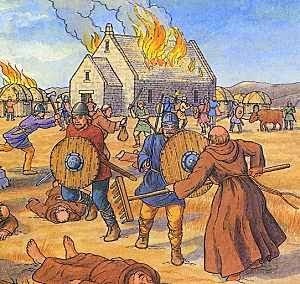
794 Vikings attacked Lindisfarne Island (northeast coast of England).
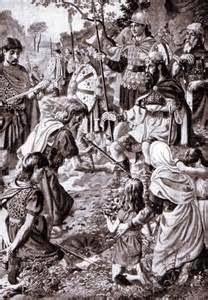
871 King Ethelred of Wessex and his brother Alfred (the Great) defeated the Danish Vikings at the Battle of Ashdown.
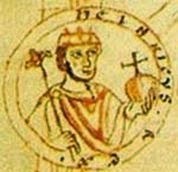
1081 Henry V, Holy Roman Emperor was born. The last of the Salic or Frankish family of rulers of the Holy Roman Empire, Henry was crowned in 1111.


794 Vikings attacked Lindisfarne Island (northeast coast of England).

871 King Ethelred of Wessex and his brother Alfred (the Great) defeated the Danish Vikings at the Battle of Ashdown.

1081 Henry V, Holy Roman Emperor was born. The last of the Salic or Frankish family of rulers of the Holy Roman Empire, Henry was crowned in 1111.

Published on January 08, 2015 03:00
January 7, 2015
Diane Turner - London Rocks - 06-01-2015
Published on January 07, 2015 05:52
History Trivia - King Edward II of England deposed
January 7
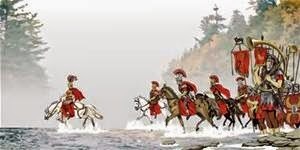
49 BC Julius Caesar was ordered to disband his army. He refused and crossed the Rubicon three days later, invaded Italy, which began a civil war.
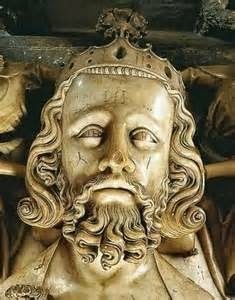
1327 King Edward II of England was deposed.

1451 the University of Glasgow Founded at the request of King James II of Scotland. Pope Nicholas V issued a bull of foundation for a studium generale. At first underfunded and lacking a place to hold lectures, the University nonetheless grew into a distinguished center of learning, its progress only briefly interrupted by the troubles of the Reformation.

1610 Galileo Galilei observed three of the four largest moons of Jupiter for the first time. He named them, and in turn the four are called the Galilean moons.


49 BC Julius Caesar was ordered to disband his army. He refused and crossed the Rubicon three days later, invaded Italy, which began a civil war.

1327 King Edward II of England was deposed.

1451 the University of Glasgow Founded at the request of King James II of Scotland. Pope Nicholas V issued a bull of foundation for a studium generale. At first underfunded and lacking a place to hold lectures, the University nonetheless grew into a distinguished center of learning, its progress only briefly interrupted by the troubles of the Reformation.

1610 Galileo Galilei observed three of the four largest moons of Jupiter for the first time. He named them, and in turn the four are called the Galilean moons.

Published on January 07, 2015 03:00
January 6, 2015
Renaissance-Era Italian Warlord Was Poisoned, Mummy Reveals
Renaissance-Era Italian Warlord Was Poisoned, Mummy Reveals
by Megan Gannon
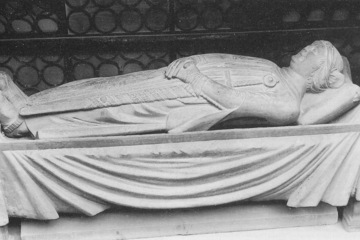
 Cangrande's carefully carved sarcophagus was opened so that his body could be studied by scientists.
Cangrande's carefully carved sarcophagus was opened so that his body could be studied by scientists.
Credit: Courtesy of Gino Fornaciari
Forensic scientists in Italy have uncovered a mummy murder mystery.
A Renaissance-era warlord who dropped dead in 1329 wasn't killed by a nasty stomach illness, as had been previously suspected; he was actually poisoned, an autopsy of his corpse reveals.
Scientists say they've found traces of digitalis, or foxglove — a beautiful but potentially heart-stopping plant — in the digestive tract of Cangrande della Scala of Verona. [Image Gallery: 7 Potent Medicinal Plants]
At the time of his death, Cangrande had a grip on an impressive chunk of northern Italy. He ruled Verona, and through successful military campaigns, he conquered the nearby cities of Vicenza, Padua and Treviso. And Cangrande wasn't just a powerful leader in battle; a true Renaissance man, he was also the leading patron of the poet Dante Alighieri.
On July 18, 1329, Cangrande made a triumphant entrance into Treviso, months after taking control of the city. But days later, he fell ill, with symptoms that included vomiting, fever and diarrhea. He died on July 22, 1329, at the age of 38.
Historical sources from that time said Cangrande died after drinking from a polluted spring. There were also rumors that Cangrande was intentionally poisoned, but Gino Fornaciari, a paleopathology researcher from the University of Pisa, who led the new study, told Live Science that he considered that possibility a legend.
Nearly 700 years later, scientists exhumed Cangrande from his richly decorated tomb at Verona's church of Santa Maria Antiqua and subjected his mummy to several medical investigations. They found that Cangrande suffered from a mild form of black lung and emphysema, probably because he was often exposed to smoky environments — palaces without fireplaces and military camps. The nobleman's bones also showed signs of arthritis consistent with regular horseriding.
In an examination of the mummy's digestive system, Fornaciari and colleagues found that Cangrande had consumed chamomile and black mulberry before his death. But then, they discovered something more unusual: foxglove pollen in Cangrande's rectum, as well as toxic concentrations of digoxin and digitoxin, two molecules from foxglove plants, in Cangrande's liver and feces samples.
"It was a real surprise," Fornaciari said in an email.
 [image error]
[image error]
 Even after nearly 700 years, Cangrande's body was relatively well preserved. Some of his clothing even survived.
Even after nearly 700 years, Cangrande's body was relatively well preserved. Some of his clothing even survived.
Credit: Courtesy of Gino FornaciariView full size imageCareful doses of foxglove have historically been used for medicinal purposes, and even today, digoxin is recognized as a treatment for congestive heart failure. But the plant is extremely potent. Eating any part of a foxglove plant — its roots; drooping flowers; or long, green leaves — can induce nausea, vomiting, diarrhea, hallucinations and a potentially fatal change in heart rate. Cangrande's symptoms described in historical accounts were consistent with a foxglove overdose, Fornaciari and his colleagues said.
The study, which appears in the February issue of the Journal of Archaeological Science, doesn't completely solve the mystery of Cangrande's death. It is still possible that Cangrande's consumption of foxglove was a terrible mistake, Fornaciari and his colleagues wrote. But if the nobleman was intentionally poisoned with foxglove — perhaps disguised in a mixture of chamomile and black mulberry — there are a few likely suspects. Rival seats of power in the region, including the Republic of Venice or Ducate of Milan, may have been behind the murder. Or perhaps Cangrande was killed by someone even closer to him: Mastino II della Scala, his ambitious nephew and successor.
by Megan Gannon

 Cangrande's carefully carved sarcophagus was opened so that his body could be studied by scientists.
Cangrande's carefully carved sarcophagus was opened so that his body could be studied by scientists.Credit: Courtesy of Gino Fornaciari
Forensic scientists in Italy have uncovered a mummy murder mystery.
A Renaissance-era warlord who dropped dead in 1329 wasn't killed by a nasty stomach illness, as had been previously suspected; he was actually poisoned, an autopsy of his corpse reveals.
Scientists say they've found traces of digitalis, or foxglove — a beautiful but potentially heart-stopping plant — in the digestive tract of Cangrande della Scala of Verona. [Image Gallery: 7 Potent Medicinal Plants]
At the time of his death, Cangrande had a grip on an impressive chunk of northern Italy. He ruled Verona, and through successful military campaigns, he conquered the nearby cities of Vicenza, Padua and Treviso. And Cangrande wasn't just a powerful leader in battle; a true Renaissance man, he was also the leading patron of the poet Dante Alighieri.
On July 18, 1329, Cangrande made a triumphant entrance into Treviso, months after taking control of the city. But days later, he fell ill, with symptoms that included vomiting, fever and diarrhea. He died on July 22, 1329, at the age of 38.
Historical sources from that time said Cangrande died after drinking from a polluted spring. There were also rumors that Cangrande was intentionally poisoned, but Gino Fornaciari, a paleopathology researcher from the University of Pisa, who led the new study, told Live Science that he considered that possibility a legend.
Nearly 700 years later, scientists exhumed Cangrande from his richly decorated tomb at Verona's church of Santa Maria Antiqua and subjected his mummy to several medical investigations. They found that Cangrande suffered from a mild form of black lung and emphysema, probably because he was often exposed to smoky environments — palaces without fireplaces and military camps. The nobleman's bones also showed signs of arthritis consistent with regular horseriding.
In an examination of the mummy's digestive system, Fornaciari and colleagues found that Cangrande had consumed chamomile and black mulberry before his death. But then, they discovered something more unusual: foxglove pollen in Cangrande's rectum, as well as toxic concentrations of digoxin and digitoxin, two molecules from foxglove plants, in Cangrande's liver and feces samples.
"It was a real surprise," Fornaciari said in an email.
 [image error]
[image error]
 Even after nearly 700 years, Cangrande's body was relatively well preserved. Some of his clothing even survived.
Even after nearly 700 years, Cangrande's body was relatively well preserved. Some of his clothing even survived.Credit: Courtesy of Gino FornaciariView full size imageCareful doses of foxglove have historically been used for medicinal purposes, and even today, digoxin is recognized as a treatment for congestive heart failure. But the plant is extremely potent. Eating any part of a foxglove plant — its roots; drooping flowers; or long, green leaves — can induce nausea, vomiting, diarrhea, hallucinations and a potentially fatal change in heart rate. Cangrande's symptoms described in historical accounts were consistent with a foxglove overdose, Fornaciari and his colleagues said.
The study, which appears in the February issue of the Journal of Archaeological Science, doesn't completely solve the mystery of Cangrande's death. It is still possible that Cangrande's consumption of foxglove was a terrible mistake, Fornaciari and his colleagues wrote. But if the nobleman was intentionally poisoned with foxglove — perhaps disguised in a mixture of chamomile and black mulberry — there are a few likely suspects. Rival seats of power in the region, including the Republic of Venice or Ducate of Milan, may have been behind the murder. Or perhaps Cangrande was killed by someone even closer to him: Mastino II della Scala, his ambitious nephew and successor.
Published on January 06, 2015 07:39
History Trivia - Harold Godwinson (last Anglo-Saxon King of England) crowned
January 6
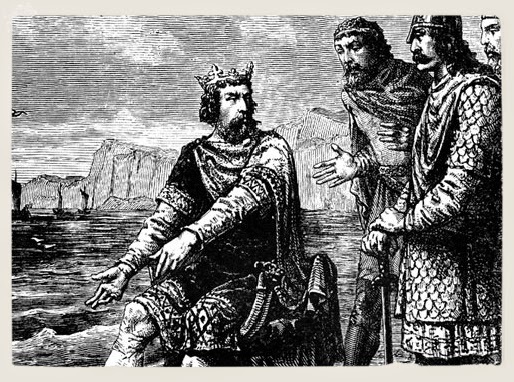
1017 Canute I crowned King of England. He was also King Canute II of Denmark and King Canute of Norway, and because of the empire he built in Britain and Scandinavia, he is sometimes known as Canute the Great.
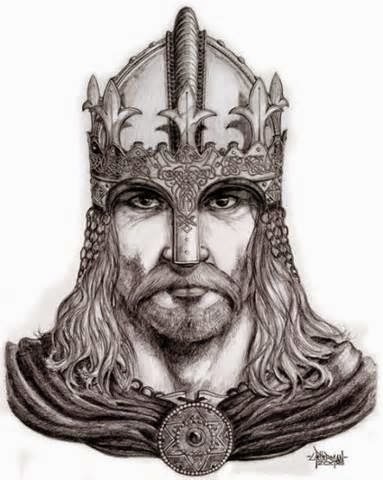
1066 Harold Godwinson (last Anglo-Saxon King of England) was crowned, most likely in Westminster Abbey.

1367 King Richard II of England was born.

1540 King Henry VIII of England married Anne of Cleves. The marriage lasted six months after which time Henry obtained a divorce and married Catherine Howard.


1017 Canute I crowned King of England. He was also King Canute II of Denmark and King Canute of Norway, and because of the empire he built in Britain and Scandinavia, he is sometimes known as Canute the Great.

1066 Harold Godwinson (last Anglo-Saxon King of England) was crowned, most likely in Westminster Abbey.

1367 King Richard II of England was born.

1540 King Henry VIII of England married Anne of Cleves. The marriage lasted six months after which time Henry obtained a divorce and married Catherine Howard.

Published on January 06, 2015 03:00
January 5, 2015
Let in the Light: Ancient Roman Fort Designed for Celestial Show
by Owen Jarus
Live Science
 The fort was constructed during the rule of Roman Emperor Hadrian (reign A.D. 117-138). It was part of a system of fortifications that protected the frontier of Roman Britain.
The fort was constructed during the rule of Roman Emperor Hadrian (reign A.D. 117-138). It was part of a system of fortifications that protected the frontier of Roman Britain.
Credit: PHB.cz (Richard Semik) | Shutterstock.com
The gateways of an ancient Roman fort in Britain are roughly aligned with the light from the sun during the summer and winter solstices — a design that would have resulted in a striking scene on the shortest and longest days of the year, a researcher says.
The fort had four gateways facing one another. During the summer solstice, the sun would rise in alignment with the fort's northeastern and southwestern gates, and set in alignment with its northwestern and southeastern gates, the researcher reported in the new study.
During the winter solstice, the sun would rise in line with the fort's southeastern and northwestern gates, and set in line with the fort's southwestern and northeastern gates. [In Photos: Amazing Ruins of the Ancient World]
Moreover, the four towers of the garrison seem aligned to cardinal directions," Amelia Carolina Sparavigna, a physics professor at the Politecnico di Torino (Polytechnic University of Turin) in Italy, wrote in the study, published Dec. 17 in the journal Philica.
 [image error] The ruins of the Roman fort in Britain by Hardknott Pass are roughly aligned with the light of the solstice sun.
[image error] The ruins of the Roman fort in Britain by Hardknott Pass are roughly aligned with the light of the solstice sun.
Credit: Satellite image copyright Infoterra Ltd & Bluesky, courtesy Amelia Carolina SparavignaView full size imageThe fort's ruins are located near Hardknott Pass in Cumbria, England, and offer a commanding view of the sprawling Eskdale Valley. Built during the reign of Emperor Hadrian, who ruled from A.D. 117 to 138, the structure was part of a series of fortifications that once guarded the Roman frontier in Britain.
Sparavigna used online software to calculate the angles at which the solstice sun rises and sets at the fort. She then used satellite maps available on Google Earth to determine how the rising and setting solstice sun compares to the fort's features.
"This image is very interesting, because we can easily imagine the sun passing through the four gates on solstices," Sparavigna said.
The summer solstice (which last occurred on June 21, 2014) represents the longest day of the year, when the sun appears at its highest point in the sky. The winter solstice (which last occurred on Dec. 21, 2014) represents the shortest day of the year, when the sun appears at its lowest point in the sky.
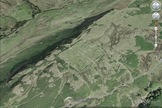 [image error] High-resolution images of the fort and its topography are available through Google Earth. These images were used along with the solstice sunrise/sunset calculations to discover the alignments.
[image error] High-resolution images of the fort and its topography are available through Google Earth. These images were used along with the solstice sunrise/sunset calculations to discover the alignments.
Credit: Satellite image copyright Infoterra Ltd & Bluesky, copyright GoogleView full size imageSun gods?
But the reason for the fort's celestial alignment remains unclear. In her paper, and in an email to Live Science, Sparavigna noted that she is not an expert on Roman religion. However, she did offer some ideas that might help to explain the alignment.
"An orientation of sacred places to sun and sky is common to several religions," Sparavigna told Live Science in an email. It is "quite possible that the Hardknott fort has a symbolic homage to the sun," she said. "The god could be Sol, the ancient Roman god of the sun, which evolved [into] Sol Invictus (a deity whose name means "unconquered sun")."
Another possible link could be with Mithra, a god of light, "whose mysteries were a religion popular in the Roman army," Sparavigna wrote in the study. The worship of Mithra originated in Persia but became popular throughout the Roman Empire.
Sparavigna also noted that there are several Roman towns in Italy that have alignments with the solstice sun. Additionally, the town of Timgad, in northern Africa, is aligned with the direction of the sunrise on the birthday of the Roman Emperor Trajan, who reigned from A.D. 98 to 117.
Live Science
 The fort was constructed during the rule of Roman Emperor Hadrian (reign A.D. 117-138). It was part of a system of fortifications that protected the frontier of Roman Britain.
The fort was constructed during the rule of Roman Emperor Hadrian (reign A.D. 117-138). It was part of a system of fortifications that protected the frontier of Roman Britain.Credit: PHB.cz (Richard Semik) | Shutterstock.com
The gateways of an ancient Roman fort in Britain are roughly aligned with the light from the sun during the summer and winter solstices — a design that would have resulted in a striking scene on the shortest and longest days of the year, a researcher says.
The fort had four gateways facing one another. During the summer solstice, the sun would rise in alignment with the fort's northeastern and southwestern gates, and set in alignment with its northwestern and southeastern gates, the researcher reported in the new study.
During the winter solstice, the sun would rise in line with the fort's southeastern and northwestern gates, and set in line with the fort's southwestern and northeastern gates. [In Photos: Amazing Ruins of the Ancient World]
Moreover, the four towers of the garrison seem aligned to cardinal directions," Amelia Carolina Sparavigna, a physics professor at the Politecnico di Torino (Polytechnic University of Turin) in Italy, wrote in the study, published Dec. 17 in the journal Philica.
 [image error] The ruins of the Roman fort in Britain by Hardknott Pass are roughly aligned with the light of the solstice sun.
[image error] The ruins of the Roman fort in Britain by Hardknott Pass are roughly aligned with the light of the solstice sun.Credit: Satellite image copyright Infoterra Ltd & Bluesky, courtesy Amelia Carolina SparavignaView full size imageThe fort's ruins are located near Hardknott Pass in Cumbria, England, and offer a commanding view of the sprawling Eskdale Valley. Built during the reign of Emperor Hadrian, who ruled from A.D. 117 to 138, the structure was part of a series of fortifications that once guarded the Roman frontier in Britain.
Sparavigna used online software to calculate the angles at which the solstice sun rises and sets at the fort. She then used satellite maps available on Google Earth to determine how the rising and setting solstice sun compares to the fort's features.
"This image is very interesting, because we can easily imagine the sun passing through the four gates on solstices," Sparavigna said.
The summer solstice (which last occurred on June 21, 2014) represents the longest day of the year, when the sun appears at its highest point in the sky. The winter solstice (which last occurred on Dec. 21, 2014) represents the shortest day of the year, when the sun appears at its lowest point in the sky.
 [image error] High-resolution images of the fort and its topography are available through Google Earth. These images were used along with the solstice sunrise/sunset calculations to discover the alignments.
[image error] High-resolution images of the fort and its topography are available through Google Earth. These images were used along with the solstice sunrise/sunset calculations to discover the alignments.Credit: Satellite image copyright Infoterra Ltd & Bluesky, copyright GoogleView full size imageSun gods?
But the reason for the fort's celestial alignment remains unclear. In her paper, and in an email to Live Science, Sparavigna noted that she is not an expert on Roman religion. However, she did offer some ideas that might help to explain the alignment.
"An orientation of sacred places to sun and sky is common to several religions," Sparavigna told Live Science in an email. It is "quite possible that the Hardknott fort has a symbolic homage to the sun," she said. "The god could be Sol, the ancient Roman god of the sun, which evolved [into] Sol Invictus (a deity whose name means "unconquered sun")."
Another possible link could be with Mithra, a god of light, "whose mysteries were a religion popular in the Roman army," Sparavigna wrote in the study. The worship of Mithra originated in Persia but became popular throughout the Roman Empire.
Sparavigna also noted that there are several Roman towns in Italy that have alignments with the solstice sun. Additionally, the town of Timgad, in northern Africa, is aligned with the direction of the sunrise on the birthday of the Roman Emperor Trajan, who reigned from A.D. 98 to 117.
Published on January 05, 2015 07:36




